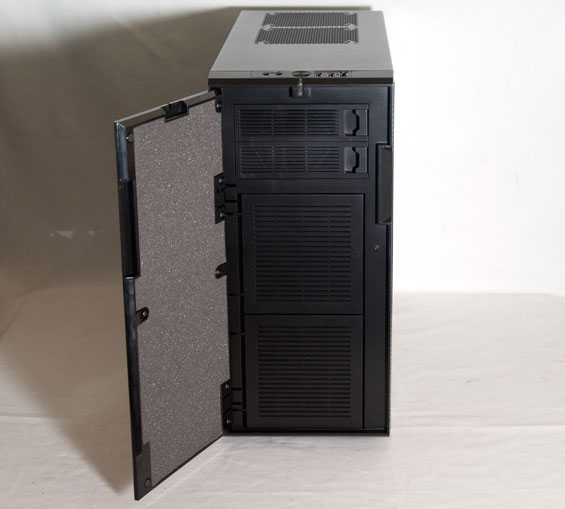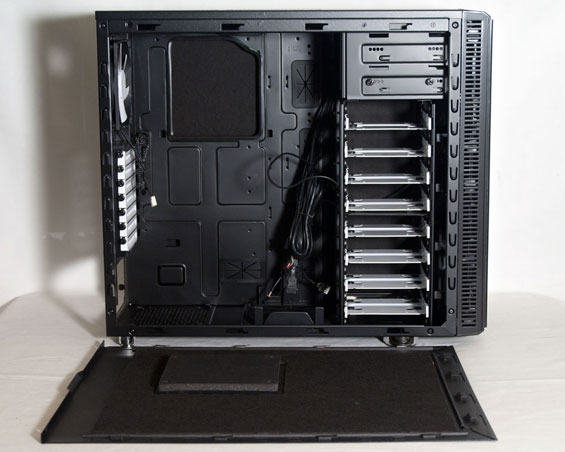Fractal Design Define R3: A Fan Favorite Keeps the Noise Down
by Dustin Sklavos on November 11, 2011 1:22 AM EST- Posted in
- Cases/Cooling/PSUs
- mid-tower
- Fractal Design
In and Around the Fractal Design Define R3
If you read our review of the Fractal Design Arc Midi, the Define R3's interior is going to seem pretty familiar. That's not necessarily a bad thing; Fractal Design brings a lot of smart ideas to the table with the two enclosures, and the R3 in particular seems to really maximize its internal real estate compared to some of the competition. It's not a big case, but there's a lot to it.

Before we get to that, though, the basics: the R3 uses a foam-padded door on the front to keep the noise in, but unlike Antec's older P180 series designs, Fractal Design wisely places the power button and I/O ports at the top of the enclosure, above the door. The result is a door that becomes less of a nuisance and more functional. When you open it, you'll find the two 120mm fan mounts (one of which is occupied) as well as just two 5.25" drive bays. Some users might chafe at the notion of being stuck with just two bays, but I honestly prefer it for most enclosures. Surrounding the door on the outside is a ventilated region that allows the intake fan to pull in air from the sides; this is an improvement over NZXT's H2, whose door threatens to completely suffocate the intakes, but it feels minimal compared to the intakes in Antec's P180 series.
The sides and bottom of the enclosure are pretty much what you've come to expect, with two fan mounts on the top, one on the side, and one on the bottom, but the difference here is that every mount but the bottom one is basically sealed off with removable acoustic foam panels. This honestly feels like such a good idea that I'm baffled as to why it's not more common, because it basically allows the R3 to succeed either as a quiet case or as a performance case (provided you add additional fans), as well as offering several points in between. I love it, and I wish more enclosure designers would implement something like this. Moving around to the back of the enclosure we see Fractal Design's traditional set of white expansion slot covers and the white exhaust fan, but otherwise nothing particularly noteworthy.

When you pop the R3 open, though, you'll see an interior that's largely well designed and really maximizes the available space. A friend of mine is in the market for a new case, and when I showed her the R3 she actually called the eight drive trays "extravagant." That may very well be, but they're an appreciated amount of expansion (even if a touch excessive), and the lateral mounting allows for easy cable routing to behind the motherboard tray. Fractal Design also includes the usual grommet-lined holes for cable routing, but they're a touch smaller in the R3. As for expansion clearance, odds are you're not going to be fitting an AMD Radeon HD 6990 or ASUS Mars II in here, but if you can afford either of those, why are you buying a $100 case? I found the clearance for power supplies, expansion cards, and CPU cooling to be just right.
Fractal Design has also padded both side panels, a much appreciated gesture keeping in line with the R3's ambitions as a silent chassis.
Ultimately I'm a fan of the R3's aesthetics (particularly the blue LED at the top center of the case that goes up and around the power button), and it's been my experience that a lot of you also like these generally sleek, minimalistic designs. The good news I have for you is that you've spoken and it seems the vendors are listening, given what Fractal Design is doing, along with BitFenix and some others. Even a recent conversation with Antec about the upcoming P280 suggests you're being heard loud and clear.
















83 Comments
View All Comments
Peskarik - Saturday, November 12, 2011 - link
Define R3 is an older design, that was what Fractal told answered me when I mentioned the fixed drive cage, which I as well find to be a nuisance.Coup27 - Friday, November 11, 2011 - link
For someone who hasn't kept pace with case designs for a long time, could somebody please explain why the PSU now goes at the bottom instead of the top?jrs77 - Friday, November 11, 2011 - link
The PSU sits in the bottom to make it easier to cool and less noisy. Usually PSUs have a thermal-controlled fan, which then runs faster, if it sucks hot air from within the case. That's why they get mounted on the bottom, where they can suck in fresh air instead, running cooler and more silent. Also, this setup allows for fans being mounted in the top as additional cooling for the CPU, etc.BTT:
The trick with the cable-routing is to rout the cables prior to installing the motherboard, then they'll fit through the grommets easily enough.
Well, and for cooling and noise... using better and more fans (Scythe S-Flex SFF21D) to drop both, temps and noise-levels does help.
The biggest plus for the Define R3 is the understatement and the sounddampening at a very low price.
The allways mentioned CM Silencio doesn't have the top-fan-mounts, which are pretty good for installing a 240mm rad.
piroroadkill - Friday, November 25, 2011 - link
For one thing, it is becoming a heavier and heavier component with increasing power needs, and I don't think 4 screws at the back and just leaving it hanging is a great idea. With it at the top you'd end up with a big shelf splitting up the case to hold it, otherwise.Bottom is actually pretty good, and it means you don't have a big mains cable trailing across the back of all your other cables round the back of your machine.
Casper42 - Friday, November 11, 2011 - link
When will some half way decent Case Mfg eventually realize that when moving the PSU to the bottom, you should really move the Optical bays as well. It doesn't seem that bad in this case because its limited to 2 Optical bays, but every other case with a bottom PSU and 3 / 4 optical bays means that after installing a nice large GPU, you effectively have created a wall between the Fans pushing cool air in at the bottom and the CPU which is now way up at the top of the case.The Cooler Master Silencio 550 that someone in the comments mentioned is a PERFECT example of this.
http://www.guru3d.com/article/cooler-master-silenc...
Look at the side shot with the video card.
So that tiny slit above the right side of the video card and a whopping 1" gap between the video card and the side panel is where your CPU gets its cool air from?
Move the damn Optical bays to the bottom so they line up with the PSU (ideally only 2 bays like the R3) and now you have 2 x 120 or 2 x 140 pushing cool air in the front that line up perfectly with the components that need the best cooling. Upper fan cools the RAM and CPU and the lower fan cools the GPU(s).
JonnyDough - Friday, November 11, 2011 - link
and thought it might benefit you, the world.http://video.pbs.org/video/1050932219
Please watch this video on PBS. It is, needless to say - quite interesting, particularly if you are not familiar with fractals.
Gnarr - Saturday, November 12, 2011 - link
Thanks for a great article :)I however want to point out that "Methodology" is the study of methods, so unless page 4 is supposed to be teaching us the methods of testing, instead of telling us what methods were used for testing, it should be called "Testing methods", not "Testing Methodology" :)
JonnyDough - Saturday, November 12, 2011 - link
Its no secret that the tech sites I read need better editors. Good catch. :DJarredWalton - Saturday, November 12, 2011 - link
Nope. Methodology: http://www.thefreedictionary.com/methodologyOnly 1b suggests methodology as the study of methods. 1a and 3 both support the use of the phrase "Testing Methodology", though "Testing Methods" is equally acceptable.
Death666Angel - Saturday, November 12, 2011 - link
I don't really see anything special here.Since you mentioned the foam, can you make a an article about foam and how it effects temperatures and noise, if at all? I think the best you can do if you want a quiet PC is choose cool running, quiet hardware. A case does not make or break a silent/cool PC. Of course, that doesn't mean cases are unimportant, they can screw some things up if they are badly designed. But mostly, it's the components inside the case that should be of concern.